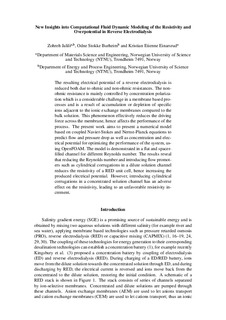| dc.contributor.author | Jalili, Zohreh | |
| dc.contributor.author | Burheim, Odne Stokke | |
| dc.contributor.author | Einarsrud, Kristian Etienne | |
| dc.date.accessioned | 2019-03-20T11:51:57Z | |
| dc.date.available | 2019-03-20T11:51:57Z | |
| dc.date.created | 2018-08-22T14:08:53Z | |
| dc.date.issued | 2018 | |
| dc.identifier.citation | ECS Transactions. 2018, 85 (13), 129-144. | nb_NO |
| dc.identifier.issn | 1938-5862 | |
| dc.identifier.uri | http://hdl.handle.net/11250/2590815 | |
| dc.description.abstract | The resulting electrical potential of a reverse electrodialysis is reduced both due to ohmic and non-ohmic resistances. The non-ohmic resistance is mainly controlled by concentration polarization which is a considerable challenge in a membrane based processes and is a result of accumulation or depletion of specific ions adjacent to the ionic exchange membranes compared to the bulk solution. This phenomenon effectively reduces the driving force across the membrane, hence affects the performance of the process. The present work aims to present a numerical model based on coupled Navier-Stokes and Nernst-Planck equations to predict flow and pressure drop as well as concentration and electrical potential for optimizing the performance of the system, using OpenFOAM. The model is demonstrated in a flat and spacer-filled channel for different Reynolds number. The results reveal that reducing the Reynolds number and introducing flow promoters such as cylindrical corrugations in a dilute solution channel reduces the resistivity of a RED unit cell, hence increasing the produced electrical potential. However, introducing cylindrical corrugations in a concentrated solution channel has an adverse effect on the resistivity, leading to an unfavorable resistivity increment. | nb_NO |
| dc.language.iso | eng | nb_NO |
| dc.publisher | Electrochemical Society | nb_NO |
| dc.relation.uri | http://ecst.ecsdl.org/content/85/13/129.abstract | |
| dc.title | New Insights into Computational Fluid Dynamic Modeling of the Resistivity and Overpotential in Reverse Electrodialysis | nb_NO |
| dc.type | Journal article | nb_NO |
| dc.type | Peer reviewed | nb_NO |
| dc.description.version | acceptedVersion | nb_NO |
| dc.source.pagenumber | 129-144 | nb_NO |
| dc.source.volume | 85 | nb_NO |
| dc.source.journal | ECS Transactions | nb_NO |
| dc.source.issue | 13 | nb_NO |
| dc.identifier.doi | 10.1149/08513.0129ecst | |
| dc.identifier.cristin | 1603813 | |
| dc.description.localcode | © 2018. This is the authors' accepted and refereed manuscript to the article. The final authenticated version is available online at: http://dx.doi.org/10.1149/08513.0129ecst | nb_NO |
| cristin.unitcode | 194,64,25,0 | |
| cristin.unitcode | 194,66,35,0 | |
| cristin.unitname | Institutt for energi- og prosessteknikk | |
| cristin.unitname | Institutt for materialteknologi | |
| cristin.ispublished | true | |
| cristin.fulltext | postprint | |
| cristin.fulltext | original | |
| cristin.qualitycode | 1 | |
